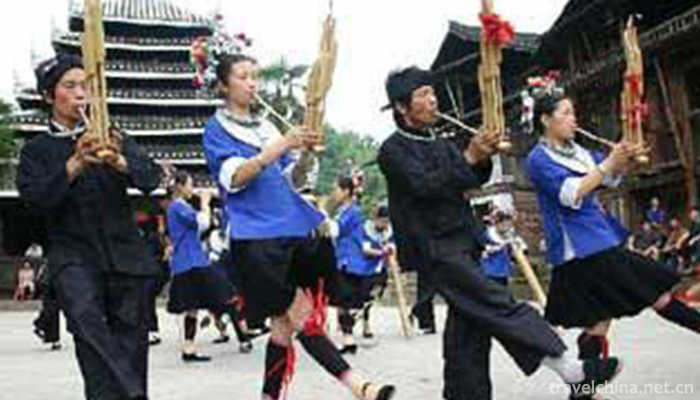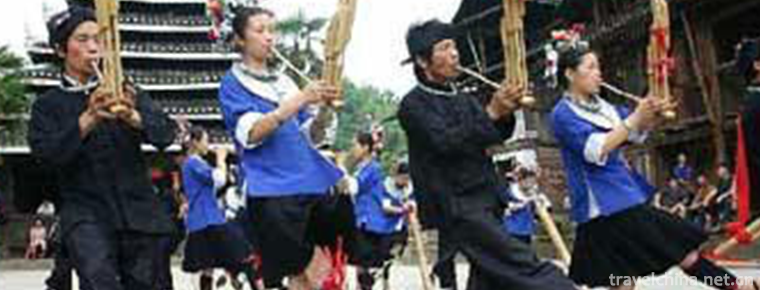Dong year
Dong year
In Dong year, Dong language is called Ninggan, also known as Winter Festival or Yang Festival. Winter Festival was originally a festival of Yang surname of Dong nationality. Initially, Yang Festival was used as Dong year in some areas of Liping, Rongjiang and Congjiang counties of Guizhou Province (between November 19 and 22 each year). Later, people gradually passed the Dong year after imitating each other.
In the early 1980s, the first day of November in the lunar calendar was the year of Dong, which was decided by the representatives of Dong nationalities from all over the country.
On May 23, 2011, the "Dong Year" declared by Rongjiang County, Guizhou Province, was listed in the third batch of national intangible cultural heritage list with the approval of the State Council.
Festival activities
During the festival, families kill pigs and sheep, chickens and ducks, invite visitors and friends for a feast. The day before the festival, they prepare tofu, fish and shrimp, cook them in sour water that night, and then cool them overnight into "frozen vegetables", on which day they sacrifice their ancestors with "frozen vegetables".
On this day, the Dong people prepared various pickles, frozen fish and bamboo buns to give to their relatives and friends, called "eating Yangbao". During the Lunar New Year, the other party should return them as many as possible, called "returning Yangbao".
The Dong people believe that after the autumn when grain is abundant, livestock is flourishing and all farming affairs are completed, the year of labor has passed and the new year is coming. Therefore, some places regard November as the beginning of the new spring, while others regard it as the end of the old year. In this regard, it is considered the end of the old year. In this regard, it is considered that the old year has gone, the new year has arrived, the grain is full of barns, and the end of the old year. When poultry and livestock are in full circle, pigs and sheep are slaughtered to celebrate the festival. Year after year, the festival is followed by the festival of the Chengdong nationality.
The Dong village in the seventy-two Zhai area of Rongjiang celebrates the New Year celebrations from the end of October to the beginning of November. In the Dong Dynasty, it is mainly a variety of flowers and presents for the elderly. It is a celebration of the ancestors. On the occasion of the new year, the family will clean up the front of the house and replace the new clothes for men, women and children. People will slaughter pigs and kill cows, and spring glutinous rice rakes. Activities, some young people take advantage of the occasion to hold wedding ceremonies, feasting relatives and friends.
In addition to the Dong year in early November, the two "accompanying years" of the performance contest are called "accompanying years". The so-called "accompanying years" refers to the Dong year at the end of November and the Spring Festival of the Han nationality accompanied by the nearby Dong people. The "accompanying year" is a program to strengthen national unity and increase friendship between the villages, both in form and in content.
There are two theories about the origin of the Dong year in this area. One is that the Longdong Dong people of Yandong first settled here, and then the ancestors of Luo, Huang, Wang and Gong came one after another. The ancestors of Luo surnamed were in harmony with the villages. On November 27, they killed pigs, slaughtered cows, beaten glutinous rice sticks and feasted their relatives. On December 1st, other families also held banquets to thank them. Another legend is that in the year of war and disorder, Luo surnamed ancestors. After hearing the news that the army was going to cross the border, it killed pigs and cattle on November 27 to celebrate the New Year. Later, other family members knew it and passed the New Year on December 1. From then on, until now, all kinds of legends have shown the festival contents of sacrificing ancestors. The rit*of the festival embodies the atmosphere of celebrating the New Year.
Inheritance and protection
In 2007, Dong year was listed in the second batch of intangible cultural heritage list of Guizhou Province.
On May 18, 2010, the State Council of China announced the third batch of national intangible cultural heritage list recommended items (new items). The "Dong Year" declared by Rongjiang County, Guizhou Province, was included in the category of folk-custom items.


-
2.The classical gardens of Suzhou
The classical gardens of Suzhou / Suzhou classical gardens, referred to as Suzhou gardens, are world cultural heritage, national AAAAA class tourist attractions
Time 2018-12-06 -
3.Three Parallel Rivers of Yunnan Protected Areas
The three rivers running side by side are Jinsha River, Lancang River and Nujiang River, three rivers originating from the Qinghai-Tibet Plateau, running 170 kilometers from north to south in Yunnan P
Time 2018-12-19 -
4.Zhongba Grand Canyon Scenic Area
Shiquan Zhongba Grand Canyon is located in the southern side of the Hanjiang River in Shiquan County, Shaanxi Province. It is 20 kilometers away from the county town
Time 2018-12-22 -
5.Jinhu Yang National Forest Park
Zepujin Lake Yang National Forest Park is located 40 kilometers southwest of Zepu County in the Gobi Depth, located in the upper edge of the Yerqiang River alluvial fan
Time 2019-01-23 -
6.88 Floor Sightseeing Hall of Jinmao Building
Jinmao Tower's 88th floor sightseeing hall, located in Shanghai, China, has a height of 340.1 meters and an area of 1520 square meters. It is the largest sightseeing hall in China at present. It is th
Time 2019-01-26 -
7.Korean Huajiali
The flower armor ceremony of the Korean nationality is one of the important rituals of the Korean nationality's birthday ceremony. Since ancient times, the Korean people have regarded respecting the e
Time 2019-04-16 -
8.regong art
Regong art is an important part of Tibetan Buddhist art in China and a school with wide influence. It originated in Longwu River Basin in Tongren County, Huangnan Tibetan Autonomous Prefecture, Qingha
Time 2019-06-11 -
9.Ten times of music
Shifan music is a traditional instrumental music spread by Hakkas in Fuzhou and Western Fujian Province. It has been circulated since the middle of Daoguang in the Qing Dynasty. The origin of Shifan m
Time 2019-06-15 -
10.Manufacturing Techniques of Wanan Compass
Wan'an compass making technology, the local traditional handicraft in Xiuning County, Anhui Province, is one of the national intangible cultural heritage.
Time 2019-06-26 -
11.Communication University Of China
Communication University of China ( Communication University of China Referred to as "Zhong Chuan", located in the capital city. Beijing Yes. Ministry of Education of the People's Republic o
Time 2019-12-03 -
12.Sports in Luzhou
By the end of 2017, there were 1654 fitness facilities and venues in Luzhou City, and 1.093 million person times of physical exercise were opened free of charge in the whole year. Six municipal level competitions including track and field, football (spring League), badminton
Time 2020-12-14